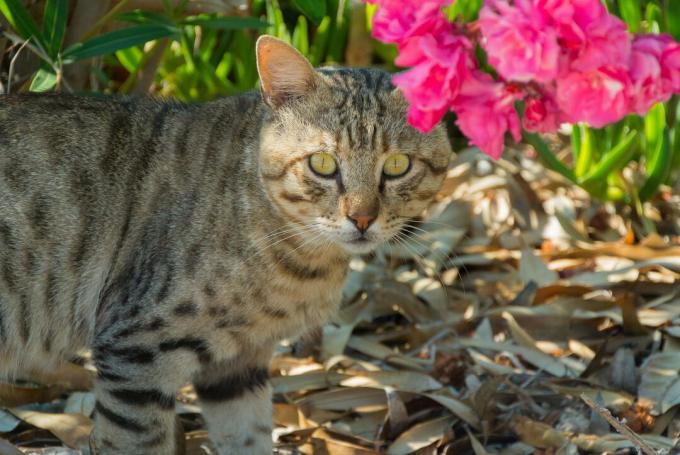As beautiful as its flowers look, the oleander is highly poisonous. We show you how to recognize and treat oleander poisoning in humans and animals.

Of the Oleander (Nerium oleander) should be consumed with extreme caution. All parts of the plant contain substances that are toxic to humans. Even so, oleander usually does not pose a threat to children or pets as it tastes very bitter. However, should something happen, it is imperative that you take immediate action to prevent serious poisoning.
contents
- Poisonous oleander
- Which parts of the oleander are poisonous?
-
Recognize poisoning with oleander
- Symptoms of poisoning in children and adults
- Symptoms of poisoning in cats, dogs and co.
- Treat poisoning with oleander
Poisonous oleander
Oleander is poisonous and the exact reason for this is the glycosides oleandrin and neandrin. The plant produces both substances as a defense against predators, but they are also effective against humans. However, many plant poisons are also used as drugs in small doses - oleandrin can for example, have a calming and invigorating effect on the heart and are used to treat skin eczema will. However, treatment with oleandrin may only be carried out using ready-to-use products from the pharmacy and under the supervision of a doctor!
Which parts of the oleander are poisonous?
Whether leaf, flower, fruit or even root - all parts of the oleander are poisonous. Although common ornamental varieties have a slightly lower toxicity level than wild varieties, they should still be handled with care. Even the smoke from the oleander is poisonous. Therefore, do not burn any green cuttings; it is best to dispose of them with household waste. The toxicity of the oleander is about the same as the toxicity of lilies of the valley (Convallaria majalis) and thimble (Digitalis purpurea). Accordingly, although it is poisonous and can even lead to death in high doses, it is less dangerous than Monkshood (Aconite) and Autumn crocus (Colchicum autumnale). Since the lethal dose is more than one leaf eaten and the leaves of the oleander taste extremely bitter, death is very unlikely. Symptoms of poisoning can occur, especially in children, when a leaf is put in the mouth.
Recognize poisoning with oleander
Oleandrin has been shown to be effective in treating heart disorders. In higher doses, however, it has the opposite effect and can be very dangerous. In order not to let it get that far, you should contact a doctor immediately if you notice any symptoms.
Symptoms of poisoning in children and adults
Poisoning with oleandrin and neandrin leads to nausea and vomiting, as well as abdominal pain and diarrhea. The blood circulation deteriorates, so that the extremities such as hands and feet become pale and cool. The poisoning can also be recognized by enlarged pupils. If the dose is too high, it can lead to cardiac arrhythmias and paralysis of the heart and breathing. The consequences of this are coma and, in extreme cases, death after two to three hours.
Note: Skin contact with the juice of the oleander can also cause irritation. It is therefore better to wear protective gloves when cutting the plant.
Symptoms of poisoning in cats, dogs and co.
Basically, animals have very similar symptoms of poisoning to children and adults: The pupils become wider, the extremities are poorly supplied with blood and become cool as a result. Vomiting and diarrhea are other symptoms.

Treat poisoning with oleander
If you have noticed from a person or an animal that part of the oleander has been eaten, immediately remove any remains of the plant that are still in your mouth. Normally, however, these are spit out immediately due to the bitter taste alone. Then the person affected should drink a lot, preferably water. Under no circumstances should you use milk, as this increases the absorption of the poison into the body. Nausea should also not be triggered. Contact a doctor immediately after these first measures!
Procedure in case of poisoning with oleander:
- Remove plant debris from your mouth
- Drink plenty of water (but never milk!)
- Contact a doctor immediately!
